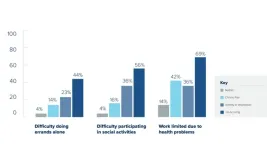(Press-News.org) Primate species with better colour vision are not more likely to have red skin or fur colouration, as previously thought.
The findings, published this week in the Biological Journal of the Linnean Society, suggest that red skin and/or red-orange fur may be beneficial for use in social communication even in primate species that don't have particularly good colour vision.
It's long been assumed that primates' colourful skin and fur is linked to their enhanced colour vision, and the results may have implications for understanding why these traits exist in different species.
Lead author Robert MacDonald from the University of Bristol explained: “There is a profusion of colour in the animal kingdom - think of the striking feathers of a bird of paradise, or the array of vivid hues on display in a coral reef.
“Mammals, though, don't tend to be so colourful, and are usually quite muted shades of black, brown, or grey.
“Primates such as monkeys, apes and lemurs are the exception to this. Several primate species have really vibrant coloration, in particular bright red skin on the face or anogenital region which can change intensity to signal things like fertility or rank in the dominance hierarchy, or red-orange fur.
“Primates also happen to have unusually good colour vision in comparison to other mammals; while all other mammals are red-green colourblind, meaning red and green appear as the same colour to them, some primates (including humans) can differentiate between shades of red and green. This enhanced colour visual system is generally thought to have evolved in order to more easily spot ripe red fruit or nutritious young red leaves among foliage, but it also makes it easier to spot the vibrant red colours that some primates exhibit.”
Primates are known to use their red colour traits for communication with other members of their species, for example in signalling information about fertility or rank in the social hierarchy. It seems intuitive that having a better colour visual system that allows these traits to stand out more might have facilitated the evolution of these traits in the first place - it would make sense for a species with better colour vision to evolve to be more colourful to take advantage of this ability.
The team set out to definitively investigate whether the evolution of enhanced colour visual system in some primates that allows the differentiation of red from green has facilitated the evolution of red colour traits.
Using photographs, the researchers categorised each species of primate in terms of having or not having particular colourful traits (e.g. red skin on the genital region or face, red-orange fur on different parts of the body). They then compared this colour information with each species' colour visual ability, taking into account the primate family tree, as well as a few other factors which might also influence coloration or colour visual ability such as whether they're nocturnal or diurnal and the size of the social group they live in. The aim was to find out whether species that have better colour vision are more likely to have red colouration, after controlling for other potential influencing factors.
Robert explained: “The fact that we didn't find that species with better colour vision are more likely to be colourful contradicts some long-held assumptions about the origins of the striking variation in colour we see within primates, and means we might have to take a closer look about what colourful red skin or fur is being used for in individual species. It shows that despite the large amount of work that has gone into investigating primate colouration in recent years, we still don't fully understand the pressures that have shaped the evolution of colour in our own closest relatives.”
Paper:
‘Primate coloration and colour vision: a comparative approach’ by Rob MacDonald et al in Biological Journal of the Linnean Society.
END
Colorful primates don’t have better color vision, study finds
2023-09-22
ELSE PRESS RELEASES FROM THIS DATE:
Large-scale German study discovers earlier puberty onset in both girls and boys with diabetes
2023-09-22
Puberty in both girls and boys with type 1 diabetes has shifted forward over the last two decades, according to research presented at the 61st Annual European Society for Paediatric Endocrinology Meeting in The Hague. Additionally longer duration of diabetes, bigger waistlines, and lower blood sugar levels were associated with even earlier puberty onset. The findings of this large-scale study highlight a close relationship between type 1 diabetes and puberty onset and the utmost importance of managing diabetes and weight ...
Novel method reveals link between man-made chemicals in everyday products and later puberty
2023-09-22
Children exposed to higher levels of synthetic chemicals in everyday products, such as water-resistant clothes, umbrellas and food packaging, are more likely to mature later during puberty, according to research presented at the 61st Annual European Society for Paediatric Endocrinology Meeting in The Hague. The findings may help better regulate the industrial production and use of these chemicals on a national and international level.
Perfluoroalkyl and polyfluoroalkyl substances (PFAS), also known ...
Benefit breakdown, 3D printed vs. wood molds
2023-09-21
Oak Ridge National Laboratory researchers have conducted a comprehensive life cycle, cost and carbon emissions analysis on 3D-printed molds for precast concrete and determined the method is economically beneficial compared to conventional wood molds.
Precast concrete is used in building construction and produced by pouring the material into a reusable mold. For decades, these molds have been made from wood — a technique that requires a highly specialized skillset. As an alternative, molds made from fiber-reinforced polymer composites can be 3D printed.
“We developed a techno-economic model that compared costs associated with each method, evaluating materials, equipment, ...
Peru’s Operation Mercury stopped most illegal gold mining in one biodiversity hotspot in the Amazon. Then the COVID-19 pandemic hit.
2023-09-21
Artisanal and small-scale gold mining is a lifeline for many who live in Madre de Dios, a region in southeastern Peru, where poverty is high and jobs are scarce. But the economic development in this part of the Amazon basin comes at a cost, as it causes deforestation, build up of sediment in rivers, and mercury contamination in nearby watersheds, threatening public health, Indigenous peoples, and the future of the biodiversity hotspot. And much of the mining activity is unauthorized.
Seeking to eliminate illegal artisanal and small-scale gold mining activity and its many negative impacts, the Peruvian government deployed “Operation Mercury” (Operation Mercurio) in February ...
Texas A&M-led humanities project seeks to preserve an endangered language
2023-09-21
Texas A&M University historian Dr. Daniel Schwartz has devoted the last decade of his professional life to preserving the past — specifically, the culture of a 2,000-year-old language known as Syriac. He and likeminded colleagues from around the world have been working across place, time and cyberspace to safeguard Syriac cultural heritage, painstakingly creating Syriaca.org, a cyberinfrastructure to link Syriac literature to their persons, places, manuscripts and key concepts.
This spring, they received another big assist from the National ...
Cancer Prevention and Research Institute of Texas awards $2 million grant to SMU
2023-09-21
DALLAS (SMU) – The Cancer Prevention and Research Institute of Texas (CPRIT) has awarded $2 million to recruit Annika Wylie to SMU and fund five years of her research, which focuses on the p53 gene, a naturally occurring tumor suppressor.
CPRIT is the state agency mandated to create and expedite innovation in the area of cancer research and enhance the potential for a medical or scientific breakthrough in both prevention and cures. CPRIT is now a $6 billion, 20-year initiative – the largest state cancer research investment ...
Study shows millions of people live with co-occuring chronic pain and mental health symptoms
2023-09-21
New University of Arizona Health Sciences research recently published in the journal PAIN found that nearly 1 in 20 adults in the U.S. experience the co-occurrence of chronic pain and anxiety or depression, resulting in functional limitations in daily life.
Prior research has shown that chronic pain along with symptoms of anxiety or depression are biologically linked. This study is one of the few to examine the national prevalence of chronic pain with anxiety or depression symptoms in adults. The results shed light on the fact that millions ...
Cardiovascular organizations pursue new, independent medical board
2023-09-21
Many of the nation’s most prominent cardiovascular organizations, representing tens of thousands of physicians, unite today to pursue the creation of a new Board for cardiovascular medicine. The proposed new Board would be independent of the American Board of Internal Medicine, where the cardiology certification process currently exists. Collectively, the American College of Cardiology (ACC), Heart Failure Society of America (HFSA), Heart Rhythm Society (HRS) and Society for Cardiovascular Angiography & Interventions (SCAI) are working together to submit a ...
Skipping counseling doesn't raise cancer gene test distress
2023-09-21
Skipping genetic counseling before or after taking a remote screening of inherited risk for ovarian or breast cancer does not increase distress, anxiety or depression, according to a study published Sept. 14 in JAMA Oncology.
“The accepted idea was that you needed genetic counseling before taking a genetic test,” said Dr. Elizabeth Swisher, a gynecologic oncologist at UW Medicine and professor of obstetrics and gynecology at the University of Washington School of Medicine. “But we’re finding out that many of these protocols actually represent ...
Nanoparticle vaccine candidate shows promise against emerging tick-borne virus in early studies
2023-09-21
Cleveland Clinic researchers have used nanoparticles to develop a potential vaccine candidate against Dabie Bandavirus, formerly known as Severe Fever with Thrombocytopenia Syndrome Virus (SFTSV), a tick-borne virus that currently has no prevention, treatment or cure.
The patent-pending vaccine uses nanoparticles to carry the antigens that contain instructions for fighting off a virus. Nanoparticle vaccines are designed to effectively deliver antigens at a lower dose with fewer side effects for at-risk ...



